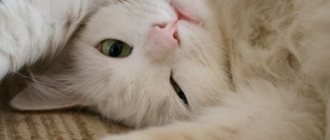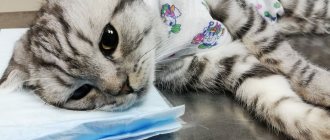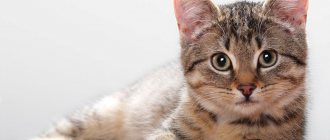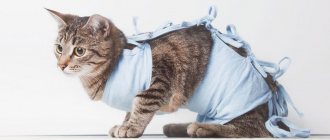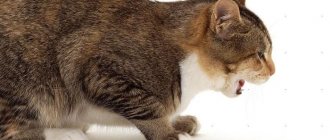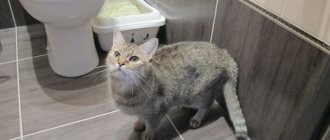15317Administration
From time to time, for various reasons, mustachioed and striped pets reject what they have eaten back, which leads to a panicky question among their owners: what to do when a cat vomits after eating, what can cause this and whether the pet has any health problems.
In fact, this is not always something to be afraid of. Regurgitation is not necessarily a symptom of illness ; often the cause of food rejection is the cat’s special physiology. But if this is repeated systematically, worrying about the cat’s health may be completely justified.
A cat regurgitates food: normal or pathological
Regurgitation of food is normal, but vomiting is pathological. Regurgitation occurs once or twice a day and not every day. The vomited material consists of food fragments or a white foamy mass. In this case, the pet is monitored and managed without the help of a veterinarian.
If attacks of vomiting occur 3 or more times a day or are repeated daily, this is a pathology that requires specialist intervention.
What not to do
When a cat regurgitates all the food one time after eating or simply rejects hairballs from time to time, nothing needs to be done. But even if your pet is vomiting, you should not:
- give human drugs (it’s hardly worth explaining why);
- drink water if it provokes additional attacks;
- give food for a day;
- give water if for some reason the animal has ingested a chemical substance;
- delay contacting a doctor if your cat vomits for more than a day.
Only competent and balanced actions of the owners will eliminate the possibility of complications of existing diseases or the transformation of ordinary food or fur rejection into a more serious problem.
The cat often burps: reasons
Regurgitation in cats is normal and occurs for the following reasons:
- Regurgitation of semi-digested food by a lactating cat occurs in order to accustom kittens to solid food.
- Toxicosis of pregnancy: occurs after two decades of gestation, when other signs have not yet appeared.
- Gluttony: wild ancestors did not have a successful hunt every day. Therefore, the animals ate for future use. But, too much food is worse than not enough. The same thing happens if the owners try to give dry food according to the norm. Or there are competitors in the apartment. The animal attacks the pellets and eats too quickly. He doesn’t have time to drink anything, dry food absorbs moisture from the gastric mucosa. The body expels dangerous food to prevent dehydration.
- Residual effects of drugs. If the animal is fed after surgery, it will vomit.
- Hungry vomiting occurs in the morning, when an animal that is accustomed to eating by the hour forgot to feed it on time. A white foamy mass appears.
- Motion sickness in transport after feeding. Pieces of food shake and irritate the walls of the stomach.
- Hairballs that a long-haired pet swallows while licking can mix with food, form trichobezoars and block the intestinal lumen. To prevent this from happening, the cat begins to cough, vomit and regurgitate dangerous lumps.
- Soured or moldy food. With improper or prolonged feeding, peroxides are formed, which the body perceives as poisons and tries to get rid of them in every possible way. An opened bag of dry food can be stored for 40 days, and a can in the refrigerator can be stored for 36 hours.
- An excess of cereals or bread with a lack of meat and vegetables is perceived by the body as spoiled food.
- Foreign object: if it comes out, vomiting stops. Otherwise, urgent veterinary attention is required.
Be sure to read:
The cat cannot pee: causes, symptoms, what to do, first aid, treatment at home
What to do when spitting up
Although regurgitation is not as dangerous as vomiting, and such nausea after eating is rarely a serious symptom, to reduce the occurrence of such situations, the pet may need help from its owners.
To do this, it is important to provide the animal with proper feeding: food should be fresh, at room temperature. It is necessary to observe the amount of food offered to the cat, as well as ensure the pet’s access to water.
If you are planning a trip, you should not feed your pet several hours before departure. During the journey, the cat regurgitates because the food is literally churned in the stomach and eventually vomited back out.
The body clearly does not accept any food - replace it.
You can try to remove the foreign object yourself, but if it is stuck deep, you should urgently take the cat to the doctor.
If a cat's regurgitation is caused by attempts to push fur out of the stomach, these manifestations can be reduced by regularly brushing the pet's coat and thus removing loose hairs (especially important for long-haired cats and during the molting period). Thanks to this procedure, “fur plugs” accumulate longer, and the animal, regurgitating hairballs, will be less likely to frighten its owners.
Types of vomiting in cats and symptoms
Pathological vomiting is almost always colored. The expelled masses should be inspected for the presence of worms, foreign objects, and pay attention to the color.
In this way, a preliminary diagnosis can be made. Responsible felinologists keep a diary in which they record everything that happens to the pet. The records will provide an invaluable service to the veterinarian in making a final diagnosis and prescribing treatment.
The following colors of pathological vomiting are distinguished:
- Bright yellow: indicates intestinal contents have entered the stomach. It occurs as a symptom of dangerous diseases - panleukopenia, helminthic infestation, liver pathologies, inflammation of the gallbladder.
- Green indicates food poisoning or a bacterial infection due to a viral infection. Green vomit also occurs with gallbladder diseases. A large amount of bile enters the stomach and is oxidized.
- Scarlet: bleeding has occurred in the pharynx or esophagus due to injury from a foreign object.
- Brown or brown - an ulcer has formed in the stomach or intestines and is bleeding. Under the influence of hydrochloric acid, the blood becomes brown in color.
- Black-brown with a fecal odor. Occurs when the intestines are blocked by trichobezoars or helminths. Requires veterinarian intervention and laboratory tests.
Differences between vomiting and regurgitation
If immediately after regurgitation the cat behaves calmly and naturally, there is nothing to worry about, this is not vomiting as such. You can distinguish vomiting from regurgitation of hair or food by the following signs:
- the process is painless, not painful;
- general condition does not worsen, there are no signs of disease;
- The cat sometimes provokes regurgitation itself as needed.
Unlike regurgitation, vomiting is accompanied by more alarming manifestations both in the state of the animal’s health and in the way this rejected mass looks:
- Thick, dark brown vomit can be caused by a tumor, ulcer, foreign object, kidney failure, or gastrointestinal disease.
- Bright scarlet inclusions indicate bleeding in the esophagus or mouth.
- White foam. It is not dangerous if done once (means that the cat ate on an empty stomach, and as a result, gastric juice, air and mucus were released). It's a bad symptom if it happens often.
- Yellow vomit indicates bile entering the stomach and irritating its mucous membrane, problems with the liver, intestines, or the cat has eaten too many eggs.
- Frequent vomiting of undigested food – problems with the intestines, gall bladder, and liver. Intestinal obstruction or infection is possible.
- Yellow-gray mass - it’s time to change industrial food.
- Green vomit is possible with severe infections or bile or intestinal contents entering the stomach. Not to be confused with regurgitation, when the green color is caused by the cat eating grass.
- Mucus impurities indicate gastritis, helminthic infestations (if there is mucus in the stool), and viral intestinal diseases.
- Vomits like a fountain when the gastrointestinal tract is completely blocked (foreign body, ICP, encephalitis, blood clots, narrowing of the canal, large accumulations of hairballs inside that were not removed in time), when under internal pressure the vomit is pushed out unexpectedly and over a long distance.
These are already very serious signs in which an emergency visit to the veterinarian can be truly vital for the pet.
A cat spits up after eating: what to do?
The cause of vomiting is the presence of food in the gastrointestinal tract. Therefore, to stop vomiting, you need to eliminate the cause - that is, food. The cat is not fed for half a day, or better yet, for a day. But you shouldn’t get carried away, because after a two-day fast, the mechanism for extracting energy from fat depots turns on. Reserve nutrients rush to the liver and a dangerous disease develops - lipidosis.
You must show your will and not react to your pet’s extortion; even a small crumb of food causes reflex vomiting. If the animal reacts to drinking, it is removed, a veterinarian is called, and before his arrival, a saline solution is injected subcutaneously in unlimited quantities.
Be sure to read:
Diarrhea in a kitten: what to do, first aid, causes, treatment, medications and folk remedies.
The next day, the pet is given some easily digestible food in an amount of no more than 1/3 of the norm. They give him plenty of water and monitor his behavior. If no new vomiting follows, increase the portion, bringing it to normal.
During diet therapy, the use of dry granules is suspended and wet nutrition is used. It is not necessary to use Smecta or Enterosgel, however, sorbents will help normalize digestion.
Symptomatic treatment
Even if regurgitation is physiological, it is worth remembering that the best treatment is prevention. Therefore, any animal must be shown to a specialist at least once a year. The veterinarian will help you choose the food that is ideal for your pet and check the general condition of the cat.
When regurgitation becomes frequent and bothers the cat, an examination needs to be carried out. To do this, the veterinarian will take blood, stool and urine tests, do an ultrasound and x-ray.
Depending on the diagnosis, treatment will be prescribed. If you follow all the specialist’s recommendations, the regurgitation will go away, like other symptoms.
Following these simple rules will also help reduce the number of regurgitations:
- You should not treat your cat yourself with medications that are intended for humans.
- You should not give water if you experience regurgitation after drinking.
- It is not recommended to force feed the animal.
- You should not experiment with food; it is better to introduce new food after consulting a specialist.
Only if breeders strictly monitor the pet’s diet and carry out treatment correctly will frequent regurgitation go away without serious consequences for the animal’s body.
Preventing regurgitation after eating in cats
To combat regurgitation, the following measures are taken:
- do not overfeed your pets, it is better to reduce portions and give them more often;
- prevent food spoilage: an opened bag of granules should be fed 40 days in advance, canned food 36 hours in advance when stored in the refrigerator;
- do not feed your pet less than 2 hours before traveling in a car;
- comb long-haired pets to minimize hair getting into the stomach when licking;
- To ensure that the hairs do not clump and come out with feces, use Malt paste or specialized super premium food.
The cat is vomiting - what to do?
There is no need to panic if the cat’s vomiting after eating occurs only once, and the animal’s condition does not cause alarm – the nose is cold, the mood is cheerful, the eyes are sparkling. This means that his health is fine and the problem was most likely caused by overeating.
If there is repeated vomiting, especially if there are impurities of blood and mucus in the rejected masses, or if the cat’s well-being deteriorates, it is necessary to show the pet to a veterinarian. If it is not possible to do this immediately, first aid must be provided to the animal. It consists of providing a starvation diet and a limited amount of water. After the vomiting stops, the cat is given easily digestible food in small portions every 2 hours - pieces of boiled chicken, baby meat puree, cottage cheese. After two days, if there is no vomiting, they switch to a normal diet.
When a cat periodically vomits after eating, what should you do in this situation? This cannot be done without medical help. There is a high risk of dehydration and loss of nutrients. Frequent vomiting may be a sign of serious gastrointestinal problems or the presence of an infectious disease.
Periodically repeated vomiting in a cat after eating can serve as a signal about the need to take anthelmintic drugs. For preventive purposes, they are given every 3–4 months.
If vomiting persists, the animal should be examined at a clinic to ensure timely treatment if necessary. Procrastination, inattention and irresponsibility of owners often cost the life of their pet.
What diets are considered unhealthy?
It is impossible to constantly feed the animal only dry food. Cat digestion also requires liquid and soft food. But we must not forget that a pet cannot eat everything that a person eats. For him, some foods from the human diet will be poisonous. Such products include tomatoes and eggplants, however, carrots should be present in the diet of your furry friend.
You should not feed your cat food that contains less than 25–30% meat. It is important that the food contains meat. Unscrupulous manufacturers often add by-products, eggs with shells, poultry bones and everything that is not usually eaten into food. Sometimes a food that is declared as a premium food contains all of the above. When choosing, you need to be very careful and careful. You should not immediately collect several packs of one type of food. If the food is sold by weight, it is better to take 100–200 grams, give it to the animal to try and monitor its reaction. The four-legged friend feels good, he does not vomit this food, which means it is suitable.
Different variants of vomiting
The precursors of undigested food from the stomach are several stages - first the cat vomits after eating, then belching follows, then the urge and the actual appearance of vomit are observed, which can be different in appearance:
- The pet vomits white foam - this is more often observed when the stomach is empty. If no other suspicious symptoms are identified, then this type of vomiting is not dangerous. Constant vomiting is a reason to go to a specialist.
- The cat is vomiting bile - most likely the pet has problems with the gallbladder or liver. This type of vomiting in a cat can be combined with white foam; in any case, you should take the purring cat to the veterinary clinic for help.
- Vomiting blood indicates a serious illness that is associated with diseases of the digestive tract. Before going to the doctor, examine the animal’s mouth - perhaps it was simply injured during an hour of play or scratched on a sharp object.
- If a cat's vomit is green, it may also be yellow with green splashes; in both cases, this is a sign of a serious illness or obstruction. In this situation, only a veterinarian can help.
If a kitten begins to vomit, it is worth examining it. Even if he vomits white foam, this is a good reason to go to the veterinary clinic.
When should you contact a veterinarian?
A pet needs veterinary help in the following cases:
- loss of interest in food;
- lethargy, decreased motor activity, lack of response to external stimuli;
- regurgitation after each meal (the animal regurgitates all or most of the food);
- uncontrollable vomiting;
- diarrhea;
- symptoms of body dehydration;
- foreign inclusions in vomit;
- breathing problems;
- deviation from normal body temperature, pulse and blood pressure.
Main reasons
The cause of your cat's vomiting is what you need to find out before starting treatment. The main reasons include many . For example:
- Any power supply errors. It happens that a cat constantly overeats, and the body simply cannot cope with the situation otherwise. However, prolonged fasting and consumption of low-quality food leads to the same consequences. That is why the owner should not leave things to chance, but personally ensure that the pet eats on time, so that there are no long breaks between meals. Otherwise, at the first opportunity, the cat will try to make up for lost time, and from overeating he will vomit.
- Formation of a hairball in the stomach. This happens very often because cats love to lick themselves and the hairs constantly accumulate. Wool cannot be digested in the stomach, which is why it forms a lump, which prevents further passage of food through the gastrointestinal tract. If there is a kitten in the house, this happens very often, but adults also have such troubles.
- Poisoning. In this case, the body tries to get rid of toxins on its own. The main advice to the owner is to avoid dehydration and be sure to give the animal water, even by force.
- Nervous system disorders and stress. It happens that an animal begins to burp because it changes its place of residence with its owners or, conversely, ends up with new owners.
- In cats, vomiting can be a sign of pregnancy, just like in women. This happens because the growing uterus puts pressure on the gastrointestinal tract, and the animal has an unbearable desire to vomit.
You also need to remember that in cats, vomiting can be a sign of chronic liver or kidney disease, pathologies of the gastrointestinal tract, or inflammation of the pancreas. It also happens that a pet begins to regurgitate food due to the presence of worms, due to infectious diseases such as leukopenia, or due to tumors in the stomach.
Owner reviews
The cat started vomiting after she ate. I wanted to take her to the vet, but everything turned out fine. Probably it was just a lot of food at once. Now I try not to overfeed.
One day I noticed that the cat was not having fun as usual. Found vomiting. I took him to the vet, it turned out to be food poisoning. They did not prescribe any special treatment, they did a wash and told me to watch the animal for a couple of days. Everything is fine.
After the walk, I noticed that the cat began to vomit. I immediately went with him to a specialist. In fact, the reason was banal - the animal found fur somewhere and that was why it was vomiting. Now I'm trying to take care of my pet.
When to go to the clinic
If within 24 hours the animal does not get better, and in addition to the described signs, any other symptoms appear (discharge from the eyes and nose, staining of vomit and feces black, vomiting bile, yellowness of the mucous membranes), then medical help cannot be avoided. .
Lack of timely diagnosis can lead to the development of other dangerous diseases, which are often the root cause of dyspepsia. If the symptoms quickly subside and the pet returns to its previous activity, then most likely the problem was minor, but repeated vomiting and diarrhea quickly lead to dehydration, threatening the animal's life.
What canned food tastes best for cats?
RESEARCH ATTENTION! You and your cat can take part in it! If you live in Moscow or the Moscow region and are ready to regularly observe how and how much your cat eats, and also remember to write it all down, you will receive FREE SET OF WET FOOD.
Project for 3–4 months. Organizer - Petkorm LLC.
Want to participate? Call!
Preventing digestive problems
A significant step for every owner should be a regular trip to the veterinarian. For healthy individuals, an annual examination is sufficient; older cats and chronic cats need to be seen by a doctor more often.
Vomiting in a cat after eating can be caused by insufficient care. Most veterinarians recommend feeding the animal daily only with high-quality food and pouring clean and settled water. Portions should be limited - with all the love for the cat, you should not overfeed your pet, otherwise he will be at risk of obesity and all the ensuing problems.
Brush your cat thoroughly weekly. Use a special brush to remove as much hair as possible, which could end up in your cat's stomach. During the shedding period, short-haired animals need combing once every two days, long-haired animals – 1-2 times a day.
Vaccinate against infectious diseases annually and deworm your cat regularly. This will help keep your immune system strong.
Breeders are advised to be attentive, monitor the condition and well-being of the pet, notice changes and respond to them.
The article is for informational purposes only. Contact your veterinarian!
What diseases can there be?
Based on the symptoms, the veterinarian will be able to determine what the pet is sick with and prescribe the necessary treatment. Diseases that cause vomiting after eating include:
To determine more precisely, it will be necessary to do an ultrasound of the gastrointestinal tract and undergo tests. After this, the veterinarian will be able to tell exactly what’s wrong with the pet and prescribe medications. There is no need to treat a cat yourself after learning his diagnosis; human medicines will not suit him, but, on the contrary, will ruin the body. If the doctor said that there are no threats and the pet is healthy, then you just need to reduce portions, drink more water and eat special grass. The cat needs grass to help its digestive system rest from food and cleanse itself.
How to cure a cat
The owner’s hopes that everything will go away on its own are often not justified. Missing time increases the chances of losing your pet. You should not self-medicate. It is impossible to find out the reason why a cat vomits after eating at home. Some drugs, used unjustifiably, only worsen the animal's condition. Treatment should be carried out under the supervision of a physician.
In case of poisoning, adsorbents are prescribed to prevent toxic substances from spreading through the bloodstream. Found traces of parasites in the vomit require deworming. If the function of the gastrointestinal tract is impaired, the doctor prescribes a course of treatment, including astringents, anti-inflammatory drugs, and a special diet. If the animal refuses food for a long time, droppers are given.
Vomiting in a cat caused by infection is especially dangerous. It is not always possible to make a diagnosis in time. If left untreated, the pet may die within a few days. After receiving the results of laboratory tests, the necessary medicine is selected in the form of immunoglobulins and special serums.
The life and health of a cat depends entirely on how caring and responsible the owner is. It is necessary to closely monitor the well-being of your pet, noticing and immediately responding to any symptoms of disease, including the cat’s vomiting of undigested food. This is the only way to ensure a long life for a pet that will respond with mutual love and devotion.
Still have questions? You can ask them to our site's in-house veterinarian, who will answer them as soon as possible in the comment box below.
Stomach upset in a kitten
The kitten’s digestive tract is not yet fully formed, which is why it is especially susceptible to damaging factors.
Most often, stomach upset in kittens occurs in the following cases:
- When artificially feeding, if the milk formula is poorly selected.
- With a sharp transition from mother's milk to an adult diet.
- When changing the diet after separation from the mother (when the kitten ends up with other owners).
If the baby is unable to suckle from his mother's breast milk, he should receive a specialized formula for cats. Feeding cow's milk, goat's milk, or infant formula can cause severe indigestion in a kitten. Cats produce less lactose than other animals, so excess milk sugar cannot be absorbed by the body, causing fermentation in the gastrointestinal tract.
In rare cases, dyspepsia develops in newborn kittens with abnormal enzyme production. In this case, only feeding with a special lactose-free formula for kittens helps.
The transition to an adult diet should be gradual. In case of abrupt weaning from the mother, if the kitten has not yet completely switched to adult food, part of the diet should be replaced with a specialized milk formula.
It is also important to ensure that after a change of owners, the kitten receives the same nutrition for the first time. The transition to other types of food should be smooth, with gradual replacement with new food over 1–2 weeks.
